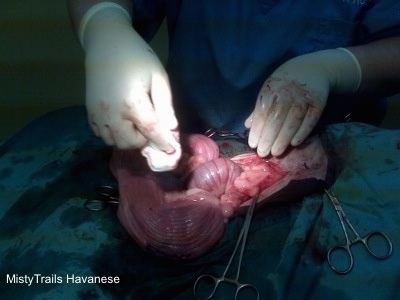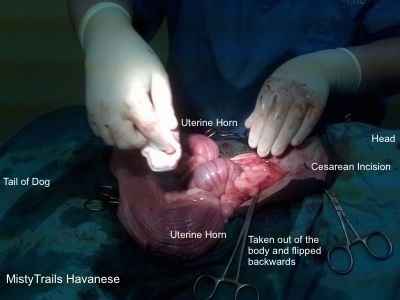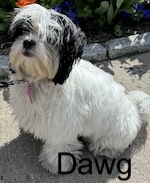Written by MistyTrails Havanese. Photos courtesy of Deanna and Katie of Victoria, B.C., Canada, along with MistyTrails Havanese.
Some causes of neonatal mortality are prolonged labor, hypoxia and dystocia. It can be physiologic and even behavioral, or even from the environment. Some puppy deaths are from a genetic problem or an infection. Studies show that 20 to 30% of all puppies born die before six months of age; most because of neonatal death.
If your intuition says something is not progressing as per your thoughts of NORMAL, seek veterinary advice. To avoid puppy deaths, you must work aggressively with your vet on the first sign of labor problems. I always advise people to go with their GUT FEELING. Pain and anxiety, including maternal stress are detrimental to the unborn puppy, so keep the dam calm. It is also good to know that some vets will ask YOU what YOU want to do. Many vets will leave the call for a C-section up to you because you know your dog. I believe there are some legal issues and reasons for the vet to like the client to make the call. One thing I find useful is to turn the question around on the vet; I ask HIM, "What would you do IF this were YOUR dam?"
Why do a Cesarean?
#1 The puppies are not deliverable, because of various reasons, including puppy size, pelvic size and shape, or even a pup in a bad position may make the call for a fast C-section in order to save the litter.
#2 Uterine Inertia - Any signs of fetal distress may make you want to quickly consider a C-section. Not all labor leads to a natural birth. Some signs of fetal stress include black, red or green discharge, which often means the placenta has detached, or there is fetal discharge (both can indicate problems).
A C-section should never be performed BEFORE the dam’s overdue date, it is always best to wait till labor starts, OR the temperature drops below 99°F and stays down. Timing a C-section is EXTREMELY important for puppy survival.
Always remember, a C-section can be a good thing, and be VERY rewarding to you and your vet.
The drugs given for a C-section are milder and safer than those given for some surgeries, as anything given to the dam will go to the puppies through the placentas, so vets use just enough to make the dam comfy, but it will not be harsh on the puppies. It must be a type that allows for fast recovery, and not have prolonged effects.
Tell your vet, do NOT use ketamine valium (ket-val), as it goes into the pups, and it takes 20 minutes to revive the pups. This is very bad for the pups. Propofol is now, by far, the best anesthetic for a C-section. It is recommended that you tell your vet to give propofol as it only lasts minutes, and then mask them down with ice-o-florine from an anesthetic machine (or JUST mask till they fall asleep). The difference with the propofol along with masking is the pups come out crying, as in a natural birth.
Isoflurane, though more expensive, can also be used. It is safe, and is not metabolized in the same way as halothane or methoxyflurane. Wakeup time for the dam is almost immediate once the medication going to the dam is stopped. Be sure to talk to your vet as to what is best for your dam.
A dam in distress, on which it has been decided to do a Cesarean section, is first given some "happy drugs," including a drug that has atropine sulfate, which helps maintain the fetal heart rates. Intravenous is inserted into usually the front leg, and often she is given fluids. Many dams in distress are dehydrated as well. The IV also helps to maintain normal blood pressure.
Prep for surgery. The dam was cleaned and shaved PRIOR to being anesthetized. A final cleansing is done before surgery.
An incision from the pubis to the umilicus is done. In some cases with large puppies, and when the uterus is overly large, the incision may need to be extended.
The dam is well covered up and kept warm, limiting the exposed areas. You do not want to get the dam too chilled. Exposing her uterus to the air can cause hypothermia, especially in small or already chilled and in shock dams.
The uterine horns are then pulled out.
An incision is made in the uterus to allow fast removal of the puppies.
A secondary staff is standing by at the door to catch puppies and tend to their immediate needs and revival.
The vet and assistant in the operating room have nothing to do with the pups after they come out.
Their hands are full, making sure ALL placental tissue is removed. They also need to close the incision.
If there were no major complications, the milk flow is not affected by the surgery, and future breedings are not affected.

The insides of a dam after a C-section. The rippled area is the uterine horn.

Never leave the dam unattended after they have had a Cesarean. Some vets stitch the dams up differently. Please discuss with your vet about internal stitches. In a six-month period we have had two breeders write in and state their dams had opened up their stitches, and their insides fell out. I have discussed this with my vet and he says it is not possible for this to happen with the way he stitches them up. It is of some concern, though, as obviously not all vets stitch up the same. In both cases where the dams undid their stitches they both died.
Some pups born from Cesarean are slow to come around. This depends on the stress level and all circumstances. The revival crew must act fast, as ALL puppies are born within a minute. As they come out, the revival staff removes sacs, cuts cords, and begins to attempt to get them all breathing. CPR, mouth-to-mouth, and aggressive rub-downs start. WARMTH, repeatedly using towels from the warmer is also needed. For a C-section, pups can take up to half an hour to stabilize and breathe on their own.
Reviving pups—when the pups start to breathe and cry, it is a HAPPY MOMENT for the revival team.
Pups in warm box
After pups are revived they are put in a warm box and the dam is brought out. Her gums are checked to pink up, and her temperature needs to be brought back up.
Some dams revive within ten minutes, some take an hour, but, as soon as she is able to hold her head up, temperature is up, and gums are pink, she can immediately go home and nurse the pups. EXTREME supervision must be given, as a dam with a hard delivery will not always accept her puppies. MAKE HER NURSE as the nursing will stimulate release of hormones from her brain to turn her into a good mom. Weigh the pups; if they are not getting milk, supplement but ONLY AFTER they have sucked on the dam for a LONG Time.
The sucking is needed to stimulate her milk production. You just sometimes need to give the pups a boost to keep their energy up, so they can suck even harder at next feeding.
Give the dam a big bowl of broth, or Mamalac as soon as she will take it. If not, syringe liquids into her.
AGAIN, a litter of C-section pups needs to be supervised. With her pain level, she can easily suffocate a pup by not knowing it is under her.
I suggest if you need a nap from an all-nighter, separate dam and pups, putting pups in a heated box.
Remember, NO drafts, NO chills, these can seriously harm a litter.
A C-section will cost you between $500 and $2,000. The normal easy C-section during business hours is about $500, then you add anything that was extra, and of course, on off hours labor is time and a half.
Extra care should be taken to watch over dams who have had C-sections. If the mother is put to sleep, then has a c-section, she'll wake up, at the vet, and then, you are going to introduce her to the pups, who, she is NOT going to believe or understand, that they are hers. Then you are going to put them on her teats, and let them suck, and she may NOT like this. You MAY have to hold her down. 100% supervision is a must, after a c-section. But after the pups nurse for 48 hours, her hormones should kick in, at least 80% of them do. It is an important step in whelping, that certain hormones are released during the birthing process. These hormones coupled with the sight of the pups arriving, and then licking the membrane, or eating part of the placenta, all play a vital role in the process of becoming a good mother. When these steps are skipped, like in the case of a section, the dam often feels estranged with the pups, she misses vital steps in the natural process, and that's what can cause dangerous episodes to occur.
IE: it has been noted in some breeds, that a dam could kill and eat her pups, but Rejection is the most common occurrence in all breeds, so you need to assist to teach them to be a good mom, as it will not always come naturally, after a c-section. Also from sedation, you cannot leave the pups with the dam, as even the BEST mom, could lie on one, and not realize it, in her drugged up state. C-sections are sometimes necessary. If your dam needs a c-section stay with her and the pups and carefully monitor their interaction, this should be done even with natural whelping, however extra time should be spent when a c-section has been performed. After a section, keep the pups in a warm box, and the Dam separate, unless you are in the room.
Just because a dam has had a c-section, depending on the reason for the c-section, she can have a normal delivery next time. If your Dam has to because she is too small, that is likely always the case. But if she has a singleton, then next time, do an xray on day 54.
Courtesy of MistyTrails Havanese
When a C-section is Necessary: Whelping and Raising Puppies
C-Section in an English Mastiff
Whelping and Raising Puppies: C-section Pictures
Whelping Stories - C-Section Due to Uterine Inertia and a Sideways Pup
